A Revolutionary New Hybrid Scrubber Electric Purification and Dust Removal Device
Discovered in 2024,HYBRID Electro Chemical SCRUBBER APPARATUS spread around the world in future.
A New Standard for Environmental Protection and a Choice for Technological Innovation
1. Technological Highlights
•Core Values of Innovative Technology
•High efficiency and comprehensive pollution treatment capability
•Smart and energy-saving design using fuzzy control
2. Core Technology and Principles
•Electrochemical Technology and Multi-layer Electrode Design
•Efficient decomposition mechanism for gas-liquid mixtures
•Advanced treatment of waste gas and wastewater with solid-liquid separation
3. Applications and Market Demand
•Adaptability across Multiple Industries
•Potential for future markets meeting ESG environmental conservation standards
4. Technological Advantages and Comparative Analysis
•Performance and economic comparisons with traditional equipment
•Dual benefits of environmental protection and economic impact for businesses
5. Contribution to Environmental Protection and Future Outlook
•A new option for environmental conservation
•Promoting green transformation through technological innovation

Overview of Technological Highlights
Unprecedented Contribution to Innovation: The Hybrid Scrubber Electric Purification and Dust Removal Equipment
1. Core Values of Innovative Technology
•The hybrid scrubber integrates electrochemical reactions and physical separation, innovating traditional waste gas and wastewater treatment methods, and offering superior solutions.
•Multi-dimensional pollution treatment: capable of simultaneously removing odors, oils, VOCs (volatile organic compounds), heavy metals, and particulates.
•Ultra-high-efficiency nano-level dust removal: achieving capture of pollutants that were previously difficult to handle with conventional technologies.
2. High Efficiency and Comprehensive Pollution Treatment Capability
•Combines wet scrubbing and electric technology to treat diverse and complex pollutants.
•Deep removal of VOCs and odors ensures safe environmental discharge.
3. Smart and Energy-Saving Design
•Fuzzy control technology enables precise operation, achieving automation and reducing manpower requirements.
•Adopts energy-efficient design, facilitating ESG compliance for energy savings and emissions reductions.
Core Technology and Principles
1. Electrochemical Technology and Multi-layer Electrode Design
․Electrochemical Principles:
‥Metal ions are released from the anode, triggering oxidation reactions that facilitate the redox of pollutants.
‥The cathode electrolyzes water, generating hydrogen and hydroxide ions to remove harmful substances.
․Multi-layer Electrode Structure:
‥Maximizes reaction area for improved efficiency.
‥Accelerates decomposition of water mist and waste gases, providing a uniform electric field to expedite pollutant treatment.
2. Efficient Decomposition Mechanism for Gas-Liquid Mixtures
․Micronized water mist and oil mist enhance contact efficiency with electrodes.
․Pulse electrochemical reaction technology optimizes pollutant decomposition in milliseconds.
3. Solid-Liquid Separation and Advanced Treatment of Waste Gas and Wastewater
․High-efficiency electric coagulation technology stabilizes solid particles for effective solid-liquid separation.
․Waste gas and wastewater discharge meets international ESG environmental standards.
Applications and Market Demand
Adaptability across Multiple Industries
1. Applications in Key Industries
․Suitable for industries with high levels of pollution, such as petrochemical, semiconductor, electronics, food processing, and manufacturing.
․Effectively tackles emissions like VOCs, particulates, odors, and oil mists.
2. Future Market Opportunities
․Meets stringent ESG environmental standards for waste treatment.
․Aligns with international green energy and environmental protection trends.
․Highly relevant for markets emphasizing carbon neutrality and circular economy goals.
Technological Advantages and Comparative Analysis
1. Creating Sustainable Social Value through Environmental Innovation
․Technological Innovation: Utilizing physical and electrochemical technologies to completely eliminate waste gas and wastewater pollution.
․Pollution Reduction: Significantly reducing the emissions of VOCs, odors, oils, fats, dust, and heavy metals.
․Energy Saving and Emissions Reduction: Supporting companies in achieving carbon neutrality through low-energy consumption.
2. Promoting Green Transition through Technological Innovation
․Establishing an entirely new pollution treatment model and providing green solutions for highly polluting industries.
․Combining modular design with fuzzy control to achieve efficient and stable operations, driving industrial upgrades.
Technological Superiority and Comparative Analysis
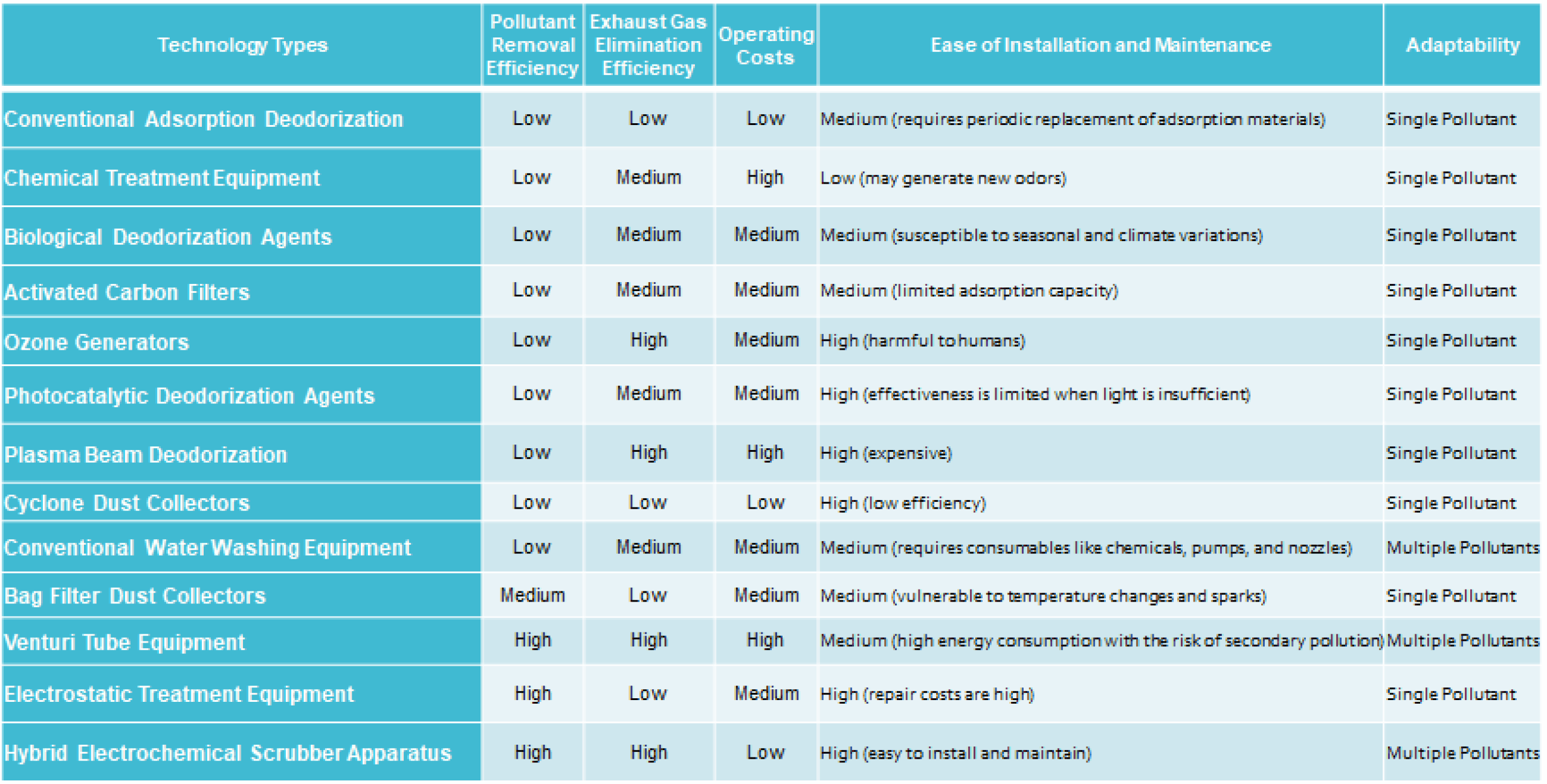
Comparison of Total Cost and Efficiency
Efficiently removes complex pollutants, avoiding multiple treatments. Reduces long-term costs.
Low maintenance frequency, stable operation, and extended equipment lifespan.
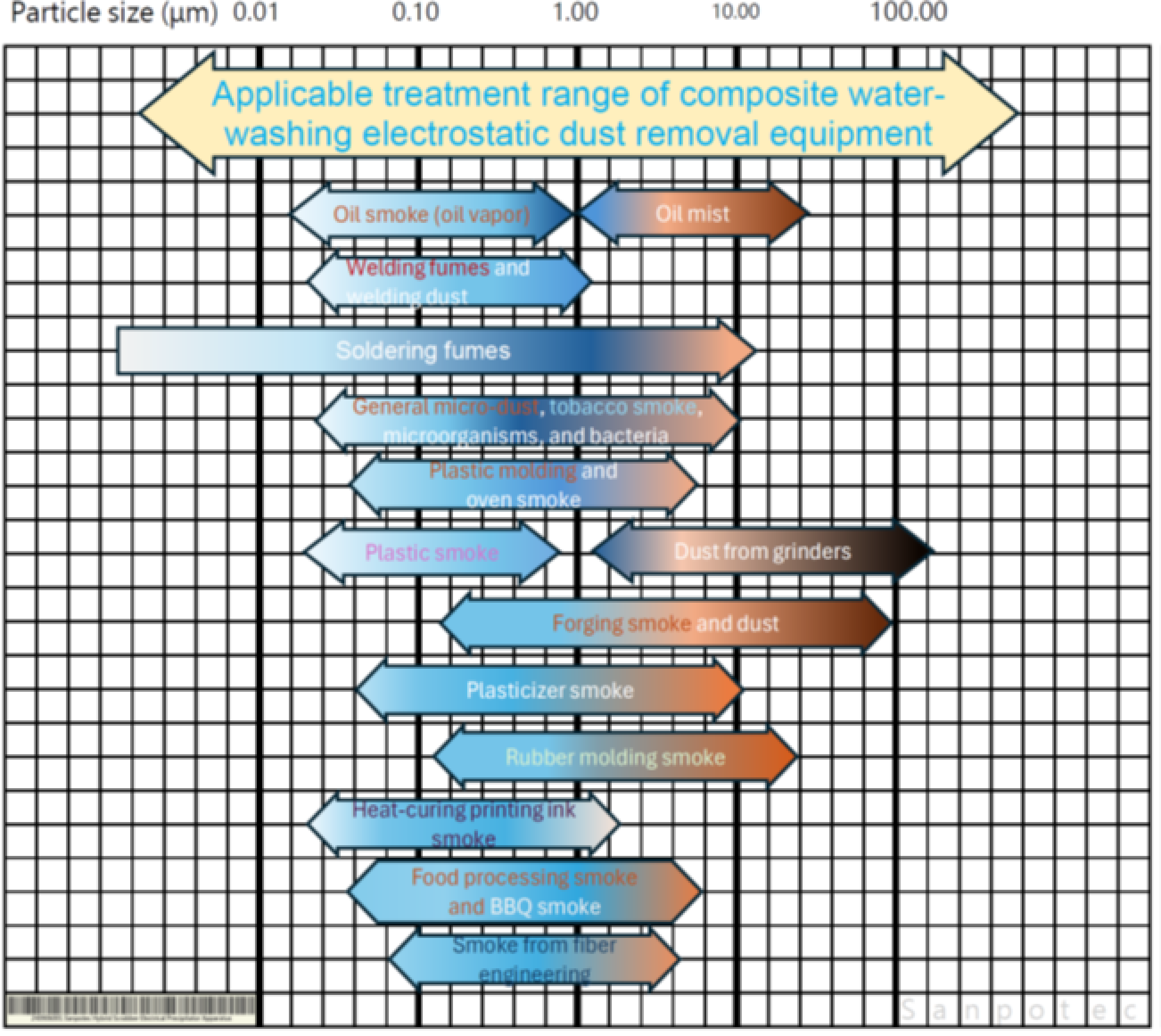 Hybrid Scrubber with Electrochemical Gas Purification and Dust Removal Range of Applications
Hybrid Scrubber with Electrochemical Gas Purification and Dust Removal Range of Applications
Core Operating Principle
Pollutant treatment after forced vortex water scrubbing
Pollutants such as exhaust gases are first subjected to forced vortex water scrubbing and then passed through metallic electrodes where an electric current is applied.
The anode releases metal ions, while the cathode electrolyzes water to produce hydrogen (H₂) and hydroxide ions (OH⁻). These ions undergo electron transfer reactions with organic and inorganic substances as well as heavy metals, resulting in oxidation-reduction reactions that decompose and remove harmful substances from exhaust gases and wastewater.
Metal ions generated through anodic oxidation react with hydroxide ions produced at the cathode to form metal hydroxides. These form sludge via physical adsorption and chemical ion exchange mechanisms. Hydrogen and oxygen produced during electrolysis help float fine sludge particles, facilitating aggregation and completing solid-liquid separation.
Electrochemical Reaction
Exhaust gases are purified via electrochemical reactions involving forced vortex water scrubbing and electrode-induced oxidation-reduction processes.
Electrode Reactions: Anode and cathode reactions
The anode releases metal ions, while the cathode electrolyzes water to produce hydrogen and hydroxide ions, removing harmful substances in wastewater through oxidation-reduction reactions.
Electrochemical Exhaust Gas and Wastewater Treatment Methods
1. Metal Ion Release from the Anode: Metal materials are used as the anode, where current passes through the anode plate, releasing metal ions into the water.
2. Water Electrolysis at the Cathode: Water is reduced at the cathode to produce hydrogen (H₂), hydroxide ions (OH⁻), and hydroxyl radicals (OH∙).
3. Oxidation-Reduction Reactions Near the Electrodes: Current induced by the potential difference between electrodes facilitates oxidation-reduction reactions with organic, inorganic, and heavy metal pollutants, decomposing harmful substances.
4. Coagulation and Co-precipitation: Colloidal metal hydroxides adsorb other suspended solids or pollutants post-decomposition, aggregating into larger solid particles.
5. Separation: The aggregated pollutants form solid flocs, which are separated through gravity sedimentation or flotation.
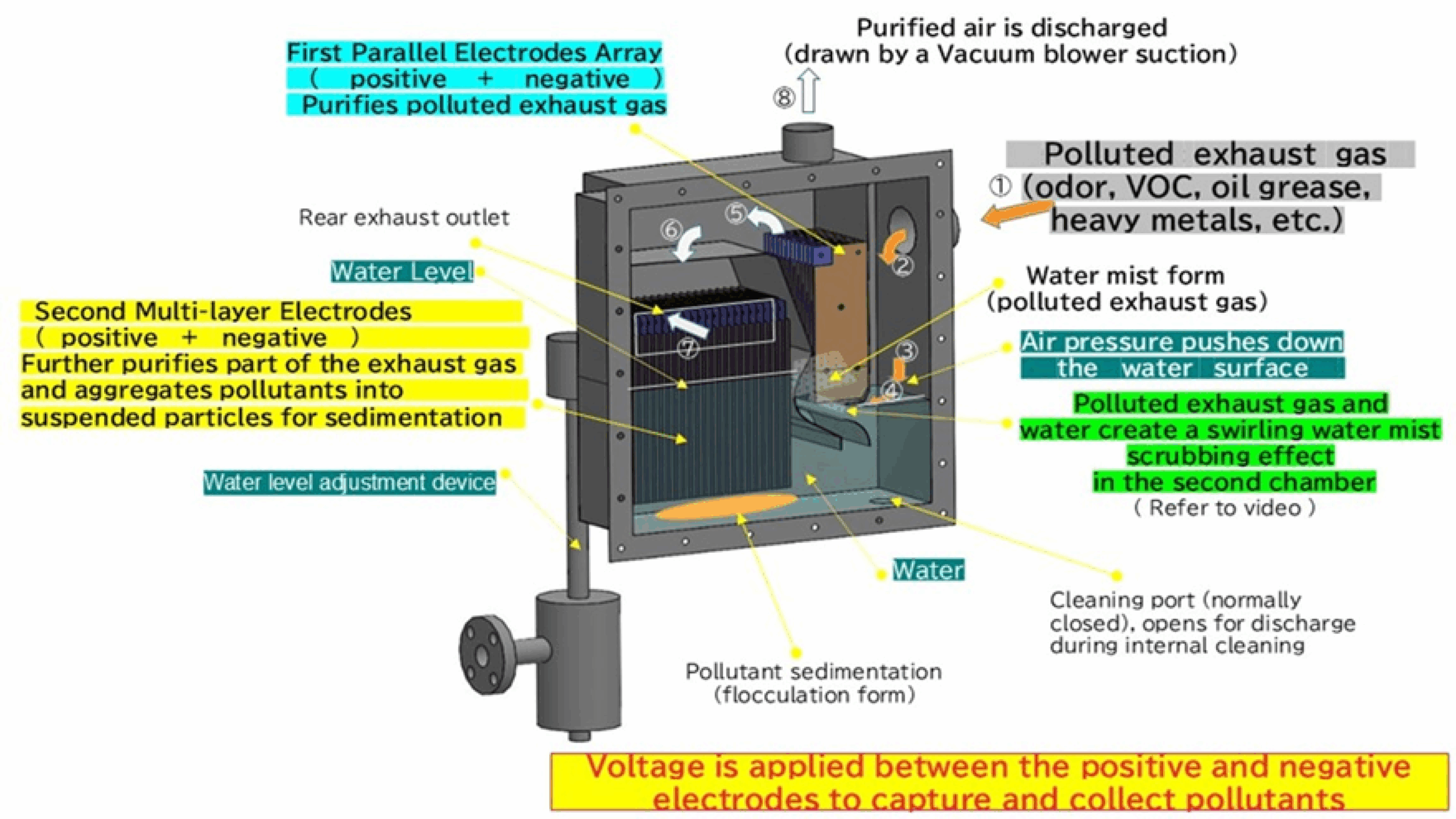
Applications
Water Washing and Dust Odor Removal via Electrolysis
Applicable effects in waste gas and odor treatment include:
1. Dust Removal from Exhaust Gases: Polluted gases are cleaned through physical mechanisms involving water-gas mixtures and electrochemical treatment to decompose pollutants.
2. Organic Compound Decomposition: Oxidation-reduction reactions break down organic waste gases through active chemical intermediates.
3. Heavy Metal Removal: OH⁻ ions bind with heavy metals to form precipitates, enabling separation.
4. Reduction of Pollutant Concentration in Water: Coagulation and sedimentation effectively reduce pollutant concentrations.
5. Oil-Water Separation: Hydrolysis via oxidation-reduction separates oils and fats.
6. Bacteria and Microbial Inhibition: Hydroxyl radicals and other generated products exhibit antibacterial or sterilization effects.
7. Ammonia Nitrogen Removal in Water: Reduces ammonia to nitrogen gas and water, removing ammonia nitrogen.
8. Fine Particle Removal: Collects fine particles to form larger flocs for easier solid-liquid separation.
9. Odor Removal: Removes odors through chemical reactions and oxidation processes.
10. Nitrate Removal: Reduces nitrates to nitrogen gas or oxidizes them into ammonia nitrogen.
Comparison with Conventional Odor Removal Systems
1. Adsorption-Based Odor Removal Devices: Use materials like activated carbon, which are cost-effective but require material replacement.
2. Chemical Odor Neutralizers: Decompose odor compounds via chemical reactions, with potential for creating new odors.
3. Biological Odor Neutralizers: Utilize microorganisms to decompose odor compounds but are affected by seasonal and climatic conditions.
4. Activated Carbon Filtration: Adsorbs odor molecules, but adsorption capacity is limited.
5. Ozone Generators: Remove odors through oxidation and decomposition, but ozone can harm humans.
6. Photocatalytic Odor Neutralizers: Use UV light to decompose odors but are less effective in low-light conditions.
7. Plasma Cluster Odor Removal Devices: Emit plasma to remove odors but are expensive.
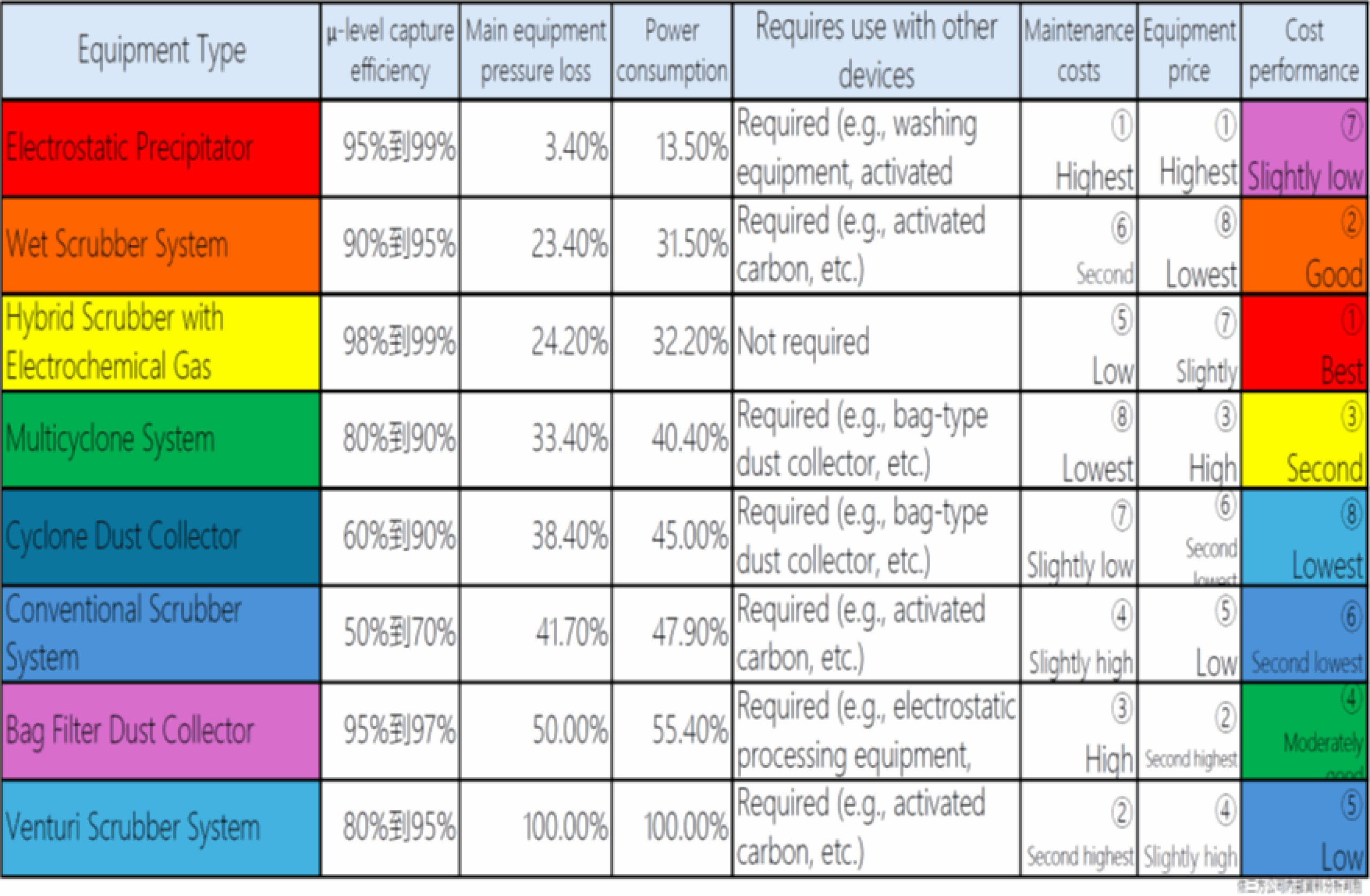
Why Hybrid Scrubber with Electrochemical Gas Purification Can Treat VOCs
Volatile Organic Compounds (VOCs) are highly volatile organic substances originating from industrial emissions, solvents, paints, and combustion processes. VOCs pose potential risks to the environment and human health, necessitating effective treatment methods.
★To address this, a novel hybrid scrubber with electrochemical gas purification and dust removal capabilities has been developed.
‧This system combines wet scrubbing and electrochemical treatment to enhance VOC removal.
In post-treatment after gas-liquid contact, the wet scrubbing method dissolves and captures some VOCs in the liquid phase.
The contact between gas and liquid phases allows odor substances in the gas phase to dissolve into the liquid phase, enabling further treatment of dissolved pollutants through electrochemical reactions.
‧For polar or water-soluble VOCs (e.g., alcohols, aldehydes), the mixture of ammonia and air passes through water, dissolving ammonia into ammonium water solution while air separates at the water surface.
Wet scrubbing efficiently removes water-soluble odor substances like ammonia and hydrogen sulfide by dividing washing water into multiple layers with electrodes, improving treatment efficiency.
‧When handling diverse pollutants (including VOCs, acidic gases like SO₂, NOx, and suspended particles), combining wet scrubbing with electrochemical treatment is ideal. This combination dissolves VOCs into the liquid phase and further decomposes them electrochemically, enhancing overall treatment efficacy.
How to Quickly Remove Odors Such as Oil Mist
Using a multilayer electrode structure, it is possible to decompose mixtures of oil mist and grease through electrochemical reactions in an extremely short time.
1. Advantages of Multilayer Electrode Design
‧Increased Surface Area: The multilayer electrode structure significantly increases the reaction surface area, enhancing contact between oil mist or grease and the electrode, thereby improving overall reaction speed.
‧Optimized Electric Field Distribution: The multilayer electrode design creates a uniform electric field within the reaction zone, allowing grease and water molecules to quickly contact and react with the electrode.
‧Spatial Efficiency: The arrangement of multilayer electrodes enables reactions to occur in a relatively small space, reducing constraints from grease or oil mist movement and further accelerating reaction rates.
2. Mechanism of Gas-Water Mixture Decomposition
In gas-phase water mist and grease mixtures, the following decomposition reactions occur:
‧Electrolysis of Water: Under a strong electric field, water molecules are rapidly electrolyzed, producing hydrogen and oxygen. When water is in a fine mist form, its surface area increases, enhancing electrolysis efficiency.
‧Electrochemical Decomposition of Grease: High-energy electrons and strong electric fields break down grease functional groups (such as ester groups), producing smaller molecules like fatty acids and glycerin as decomposition products.
3. High Reactivity of Water and Oil Mist
Water molecules in oil mist are more easily electrolyzed than in liquid water.
‧The small volume and large surface area of mist droplets increase the contact area with the electrode, accelerating electrochemical reactions.
‧As a result, water electrolysis completes in milliseconds, and dissolved oxygen and other gases further react through electrochemical processes.
4. Effects of Electric Fields and Pulsed Current
Using electric fields or pulsed current technology significantly shortens reaction times:
‧Electric Fields: Near the electrode surface, a very high electron density is generated, accelerating electron movement and reaction rates. Consequently, the decomposition of water, oil mist, and grease completes in less than a few seconds.
‧Pulsed Current: Pulsed current delivers instantaneous energy, triggering decomposition reactions for water, oil mist, and grease. This method enables localized electrochemical reactions to complete in microseconds to milliseconds.
‧Localized High-Temperature Effects: The current induces temporary high temperatures on the electrode surface or localized areas, further accelerating decomposition reactions.
Dust Removal, Deodorization, and Oil Removal Equipment Comparison
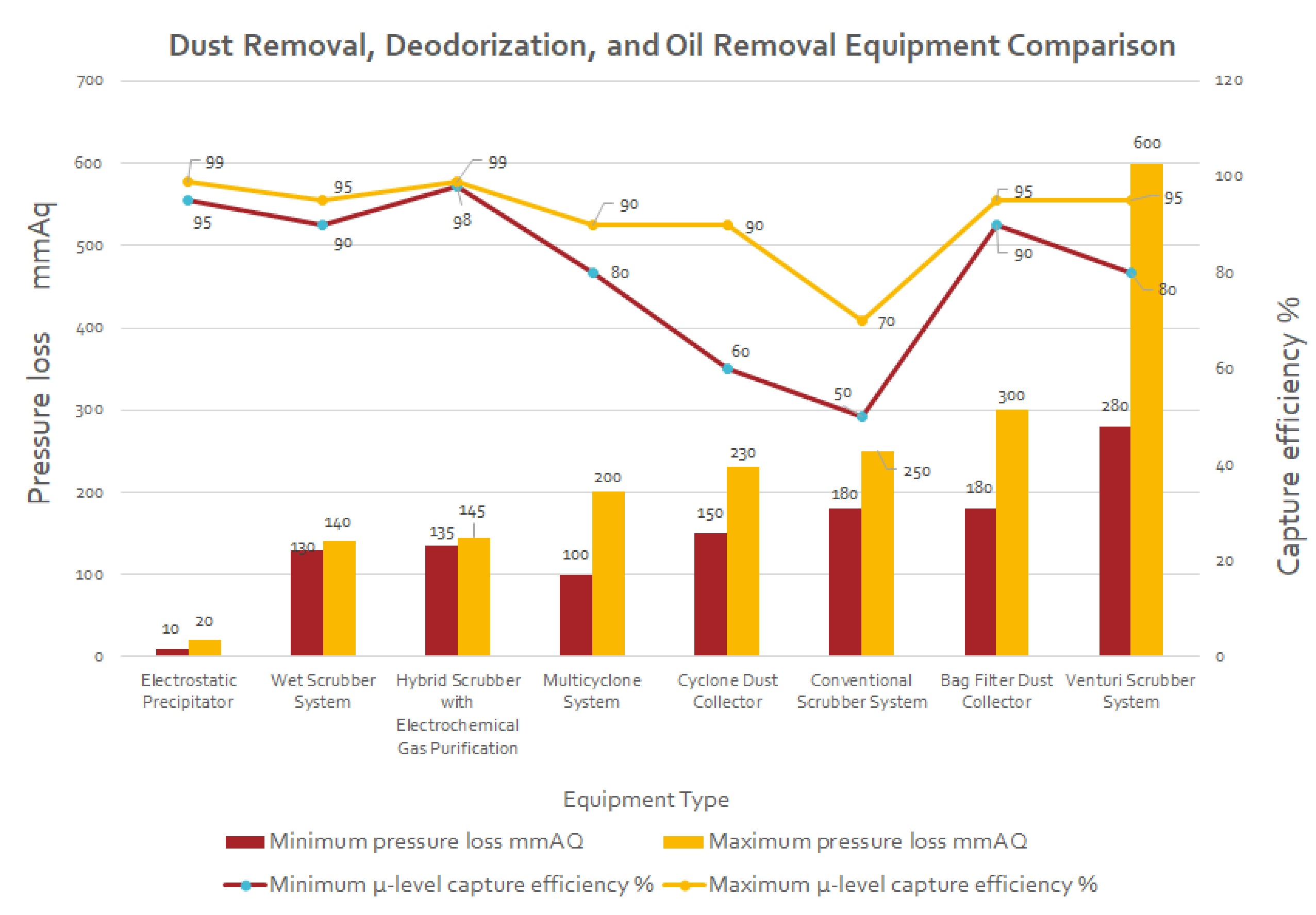
Comparison of Energy Consumption Between Conventional Dust Collection Equipment and the Hybrid Scrubber System
For similar processing environments, energy consumption is calculated based on the following assumptions:
Airflow: 200 Nm³/min
Dusty exhaust gas temperature: 120°C
Pipe length: 80 meters
Six 90-degree bends
Total vertical length: 15 meters
The actual airflow at 120°C is approximately 288 m³/min, with a pressure loss of 70 mmH₂O.
1. Electrostatic Precipitator:
‧Collection efficiency for particles at the micron level: 95%-99%
‧Equipment pressure loss: 10-20 mmH₂O; fan pressure: 90 mmH₂O
‧Estimated fan power: ≥8.1 kW
2. Wet Scrubber System:
‧Collection efficiency: 90%-95%
‧Equipment pressure loss: 130-140 mmH₂O; fan pressure: 210 mmH₂O
‧Estimated fan power: ≥18.9 kW
3. Hybrid Scrubber with Electrochemical Gas Purification:
‧Collection efficiency: ≥98%
‧Equipment pressure loss: 135-145 mmH₂O; fan pressure: 215 mmH₂O
‧Estimated fan power: ≥19.3 kW
4. Multicyclone System:
‧Collection efficiency: 80%-90%
‧Equipment pressure loss: 100-200 mmH₂O; fan pressure: 270 mmH₂O
‧Estimated fan power: ≥24.2 kW
5. Cyclone Dust Collector:
‧Collection efficiency: 60%-90%
‧Equipment pressure loss: 150-230 mmH₂O; fan pressure: 300 mmH₂O
‧Estimated fan power: ≥27 kW
6. Conventional Scrubber System:
‧Collection efficiency: 50%-70%
‧Equipment pressure loss: 180-250 mmH₂O; fan pressure: 320 mmH₂O
‧Estimated fan power: ≥28.7 kW
7. Bag Filter Dust Collector:
‧Collection efficiency: 95%
‧Equipment pressure loss: 180-300 mmH₂O; fan pressure: 370 mmH₂O
‧Estimated fan power: ≥33.2 kW
8. Venturi Scrubber System:
‧Collection efficiency: 80%-95%
‧Equipment pressure loss: 280-600 mmH₂O; fan pressure: 670 mmH₂O
‧Estimated fan power: ≥60 kW
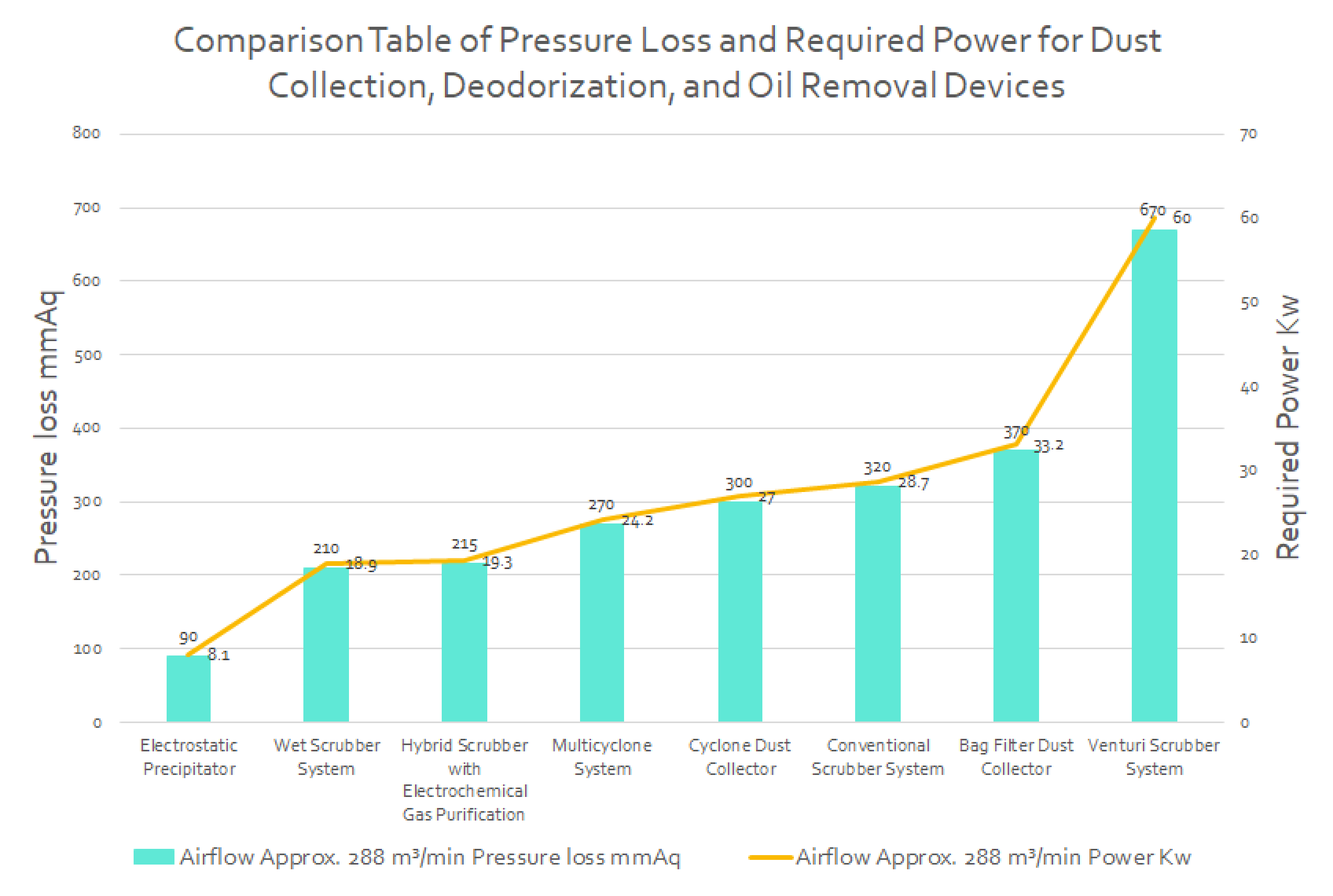 Comparison Table of Pressure Loss and Required Power for Dust Collection, Deodorization, and Oil Removal Devices Cost Performance
Comparison Table of Pressure Loss and Required Power for Dust Collection, Deodorization, and Oil Removal Devices Cost Performance
Summary
The Hybrid Scrubber with Electrochemical Gas Purification combines physical and chemical processes to effectively treat particles, dust, grease, organic and inorganic pollutants, and heavy metals in exhaust gas and wastewater. Its innovative design and multifunctional processing capabilities make it an optimal solution for modern pollution control, providing efficiency, cost-effectiveness, and sustainability.
